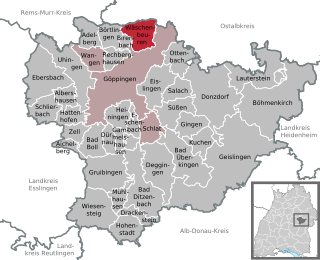
The Hohenstaufen dynasty, also known as the Staufer, was a noble family of unclear origin that rose to rule the Duchy of Swabia from 1079, and to royal rule in the Holy Roman Empire during the Middle Ages from 1138 until 1254. The dynasty's most prominent rulers – Frederick I (1155), Henry VI (1191) and Frederick II (1220) – ascended the imperial throne and also reigned over Italy and Burgundy. The non-contemporary name of 'Hohenstaufen' is derived from the family's Hohenstaufen Castle on Hohenstaufen mountain at the northern fringes of the Swabian Jura, near the town of Göppingen. Under Hohenstaufen rule, the Holy Roman Empire reached its greatest territorial extent from 1155 to 1268.

Göppingen is a town in southern Germany, part of the Stuttgart Region of Baden-Württemberg. It is the capital of the district Göppingen. Göppingen is home to the toy company Märklin, and it is the birthplace of football player Jürgen Klinsmann. It also hosts the headquarters of TeamViewer AG.
Nassau, derived from the town of Nassau on the Lahn River in Rhineland-Palatinate, Germany, gained historical significance through the House of Nassau. The noble dynasty later formed the Dutch royal House of Orange-Nassau following William I's inheritance of the Principality of Orange in 1544, leading to the adoption of the name Nassau across various locations and institutions worldwide. The name traces its etymology to German nass (wet) and Au(e) (floodplain).

The House of Welf is a European dynasty that has included many German and British monarchs from the 11th to 20th century and Emperor Ivan VI of Russia in the 18th century. The originally Franconian family from the Meuse-Moselle area was closely related to the imperial family of the Carolingians.
9th Division, 9th Infantry Division or 9th Armoured Division may refer to:

The 9th SS Panzer Division "Hohenstaufen" was a Waffen-SS armoured division of Nazi Germany during World War II. It participated in battles on both the Eastern and Western Fronts. The division was activated in December 1942. Many of the men of the division were young German conscripts, with a cadre of NCOs and staff from the SS Division Leibstandarte and other Waffen SS divisions. Hohenstaufen took part in the relief of German forces in the Kamenets-Podolsky pocket, the Normandy battles, Operation Market Garden, the Ardennes Offensive and Operation Spring Awakening. The division surrendered to the United States Army on 8 May 1945, at Steyr.
Prince Eugene most commonly refers to:
Thomas Müller was a German Waffen-SS officer who commanded the SS-NCO Training School (Waffen-SS-Unterführerschule) in Radolfzell, 9th SS Panzer Division Hohenstaufen, 17th SS Panzergrenadier Division Götz von Berlichingen and the 6th SS Volunteer Sturmbrigade Langemarck during World War II. He saw action on the East and the West, finishing the war on the Oder front.

The Harzburg, also called Große Harzburg, is a former imperial castle, situated on the northwestern edge of the Harz mountain range overlooking the spa resort of Bad Harzburg in Goslar District in the state of Lower Saxony, Germany. It was erected from 1065 to 1068 at the behest of King Henry IV of Germany, slighted during the Saxon Rebellion in 1073-75, and a century later rebuilt under Emperor Frederick Barbarossa and his Welf successor Otto IV, who died here in 1218.

Trifels Castle is a reconstructed medieval castle at an elevation of 500 m (1,600 ft) near the small town of Annweiler, in the Palatinate region of southwestern Germany. It is located high above the Queich valley within the Palatinate Forest on one peak of a red sandstone mountain split into three. Trifels Castle is on the peak of the Sonnenberg, and on both of the other two rock elevations there are castle ruins: Anebos Castle and Scharfenberg Castle.
Walter Harzer was a German SS commander during the Nazi era. He commanded the SS Division Hohenstaufen and SS Polizei Division.

Ottenbach is a municipality in the district of Göppingen in Baden-Württemberg in southern Germany.

Wäschenbeuren is a town in the district of Göppingen in Baden-Württemberg in southern Germany.

Hohenstaufen Castle is a ruined castle in Göppingen in Baden-Württemberg, Germany. The hill castle was built in the 11th century, on a conical hill between the Rems and Fils rivers in what was then the Duchy of Swabia. It was the seat of the Staufer (Hohenstaufen) dynasty, the Dukes of Swabia for the period of 1079–1268, with three Holy Roman Emperors during 1155–1250. The castle was destroyed in the German Peasants' War of 1525.

The Drei Kaiserberge Hohenstaufen, Rechberg and Stuifen are inlier mountains of the Swabian Alb in Baden-Württemberg, Germany. They form a distinctive group between Göppingen and Schwäbisch Gmünd and are a widely visible and prominent feature of the region. Since 4 October 1971, they have been protected together with Aasrücken and Rehgebirge as a Landschaftsschutzgebiet.
Göppingen station is a station in the town of Göppingen in the German state of Baden-Württemberg. It is a transit station and is situated km 42.1 from Stuttgart on the Fils Valley Railway, which was completed in 1850 from Stuttgart to Ulm.

The Rechberg is one of the three Imperial mountains near Göppingen in Baden-Württemberg in southern Germany. Together with the Hohenstaufen and Stuifen, it forms the so-called "Three Kaiser mountains".

Hohenrechberg Castle is a ruined castle in Schwäbisch Gmünd in Baden-Württemberg, Germany. It was built as a spur castle on the spur of the Hohenrechberg mountain, which forms together with the Hohenstaufen Mountain and Stuifen the Three Emperors Mountains, just a few kilometers next to the family seat Hohenstaufen castle of the Staufer dynasty.
This page is based on this
Wikipedia article Text is available under the
CC BY-SA 4.0 license; additional terms may apply.
Images, videos and audio are available under their respective licenses.











